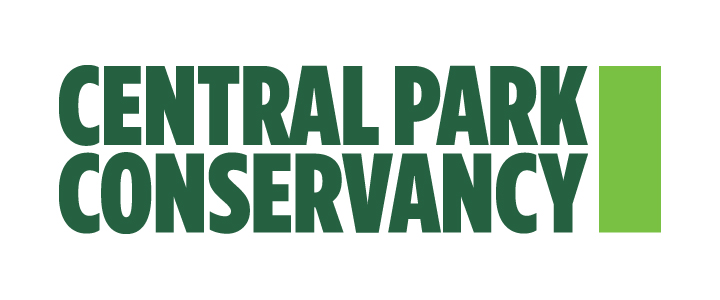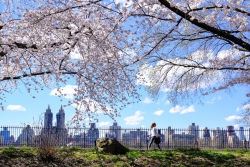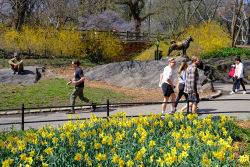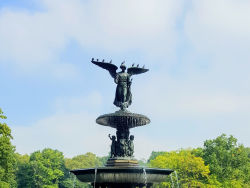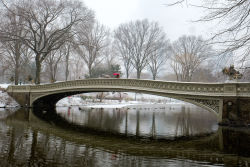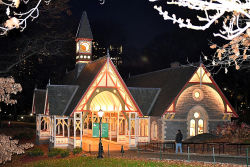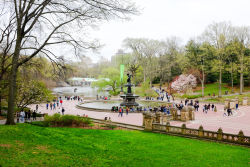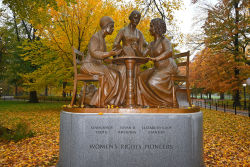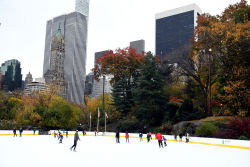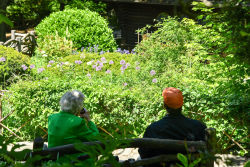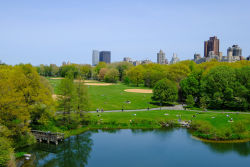Central Park
The Daily Plant : Tuesday, July 15, 2003
REDISCOVERING THE MAGNIFICENT BEECH
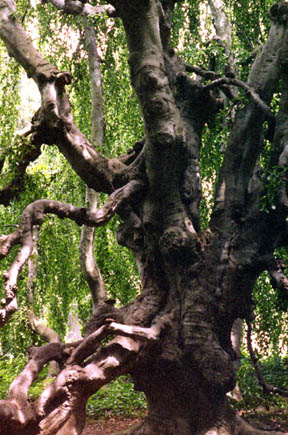
A few weeks ago, while visiting relatives in Chester County, Pennsylvania, I saw one of the oldest weeping beech trees in the country. Planted by one of Pennsylvania’s first settlers, it was over three hundred years old. A weeping beech of that age is an impressive and weird sight. From a distance, it looks nothing like a tree; it appears to be an enormous mound of leaves piled up in the middle of the landscape. Instead of reaching out and up towards the sky, the branches droop and touch the ground, forming a curtain around the tree. The weeping beech I saw had a leaf curtain that appeared to be over 100 feet in diameter. There were so many branches that the leaves seemed to be growing uncontrollably, cascading over top one another, like water in a fountain. Behind the leaf curtain, the tree was even more impressive. It’s trunk was thick and twisted and split into several parts. The largest branches rested on the ground or were supported by wooden ladders, while new branches twisted upward and interlaced with each other, to form the dark umbrella, like the canopy I had observed from the outside.
Back in New York, I learned that Queens’ Weeping Beech Park was once home to a beech of similar proportions. The weeping beech that grew there was legendary, and survived for 151 years, from 1847 to 1998. It grew to a height of 60 feet and its leaf curtain, or "outer circle," reached a diameter of approximately 80 feet. The magnificent tree was survived by its five "daughters"—trees that grew from root shoots from the main trunk. Joe Bonkowski, Parks & Recreation’s Director of Landscape Mangement in Queens, called the "daughters" strong specimens, saying, "even though the main tree is gone, its daughters, which are exact clones, will live on." All of Queens’ beeches were originally from Europe, cloned from a weeping beech that grew on a nobleman’s estate in Beersal, Belgium.
There are two types of beech trees: European and American. The two trees I have described are European. A European beech is characterized by its interlacing surface roots, its thick, knotty trunk, and its dark, wavy, foliage. An American beech tends to have a taller, thinner, trunk, and leaves that are thinner and sharper-toothed than its European cousin. You can find both European and American and American beeches in our city’s parks. In Central Park, there’s a beautiful old European beech on the East Drive at 97th Street. Also in Manhattan, there’s a European beech in Inwood Hill Park, on the west ridge, northwest of Clove. In Brooklyn, you can find European beeches in Owl’s Head Park, near the playground and comfort station and in Queens, you can find a European beech in the western section of McNeil Park, and of course, in Weeping Beech Park. Although not a City park, the Bronx’s Wave Hill is home to copper beeches that are more than a hundred years old and are known as some of the most spectacular beeches on the Eastern seaboard. American Beeches are more elusive; they are not planted as decorative trees and often grow as part of larger forests. They can be found in the ravine of Prospect Park’s native forest, in front of the Friends Cemetary. In Van Cortlandt Park, they grow on Cass Gallagher trail and in Alley Pond Park, they grow in a section of the park called "The Oaks." American beeches grow in Pelham Bay Park, near the environmental center, and in Inwood Hill Park, they grow at the entrance to the forest, west of the playing fields. Finally, they can be found throughout Staten Island’s Greenbelt, in High Rock Park.
If you’ve never admired a beech tree, I encourage you to visit one soon. Their pale blue bark is soothing to look at and they are perfect for sitting beneath on a hot summer day. Once you’ve seen one, you’ll return to them again and again, to admire their sturdy beauty enjoy their abundant shade.
Written by Hannah Gersen
QUOTATION FOR THE DAY
"This is my letter to the World
That never wrote to Me –
The simple News that Nature told –
With tender Majesty."
Emily Dickinson
(1830-1886)
Check out your park's Vital Signs
Clean & Safe
Green & Resilient
Empowered & Engaged Users
Share your feedback or learn more about how this park is part of a
Vital Park System
Contacts
Central Park Information: (212) 310-6600
Central Park Information (for the Hearing Impaired): (800) 281-5722
Belvedere Castle, The Henry Luce Nature Observatory: (212) 772-0210
The Charles A. Dana Discovery Center: (212) 860-1370
The Dairy Visitor Center and Gift Shop: (212) 794-6564
North Meadow Recreation Center: (212) 348-4867
Loeb Boathouse (Bike rentals, boat rentals & gondolas): (212) 517-2233
Carousel: (212) 879-0244
Fishing at Harlem Meer (Catch & Release): (212) 860-1370
Harlem Meer Performance Festival: (212) 860-1370
Horseback Riding - Claremont Stables: (212) 724-5100
Metropolitan Opera (Performances on the Great Lawn): (212) 362-6000
New York Philharmonic (Performances on the Great Lawn): (212) 875-5709
Shakespeare in the Park - The Public Theater at the Delacorte Theater: (212) 539-8655
Central Park SummerStage: (212) 360-2777
Swedish Cottage Marionette Theater: (212) 988-9093
Tennis: (212) 280-0205
Weddings, Ceremonies and Photography at the Conservatory Garden: (212) 360-2766
Wildlife Center & Tisch Children's Zoo: (212) 439-6500

